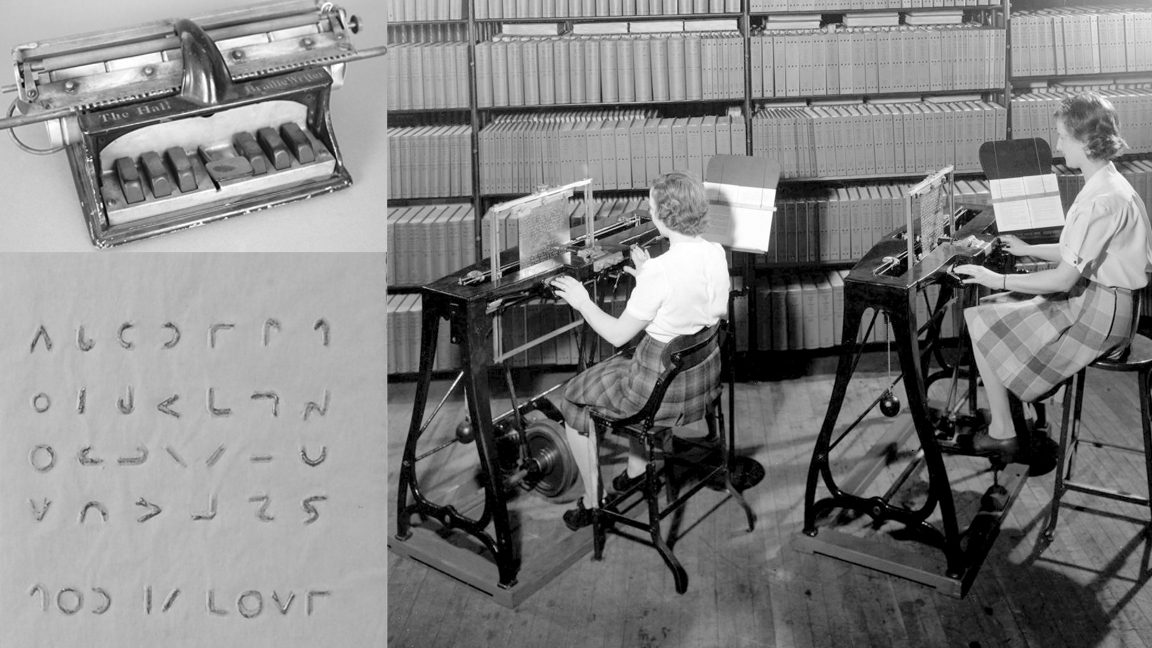Environment: dev.aph.org — Current roles: guest
 A Lot of Dots
A Lot of Dots
Photos above from Museum Archives: Hall braillewriter 1892; APH employees typing braille printing plates with stereograph machines, c. 1945; detail from a printing plate of Moon Type, 1890s.
When starting a new job there is always a learning curve period—of familiarizing yourself with the day-to-day aspects of the job, meeting new co-workers, and simply learning your way around the building and supply closet (where on earth is a box cutter?). Having worked in the museum field for most of my career, I was confident in my abilities to contribute to the team in that regard. However, my foray into the world of blindness was admittedly fairly minimal prior to this position. In recent years I had the opportunity to participate in accessibility trainings, some of which were led by Museum Director Mike Hudson. After attending the Blindness 101 program, I naively thought I knew more than the average person about blindness. Like most things in life, you don’t realize just how much you don’t know until you really dive into something.
I started my new position as Museum Collections Manager at the end of May. Since the museum hadn’t reopened yet from the pandemic, I was fortunate to have the time to dive straight into learning about the history of APH, schools for the blind, early tactile books, and braille. Oh, how little I knew about braille… I knew nothing about the history of braille, or that Braille was also a person. I had never heard of Boston Line Letter, or New York Point before, or that American braille used to differ from British braille, or that braille has contractions. Moon Type blew my mind (and also, is just so cool). My mind was buzzing on a daily basis from all of this new knowledge. I’m a learner, and I have a voracious appetite when it comes to learning new things. I’m constantly going down rabbit holes, only to emerge from one and fall down another one. APH is certainly providing me with many opportunities to increase my knowledge. The history is all so fascinating!
To assist with my work, I learned the braille alphabet and numbers. I want to learn contractions down the road, but I’m pretty proud of myself when I can read something in (albeit Grade 1) braille. It’s very slow going, and I sometimes forget what the word was by the time I’ve gotten to the last letter, so I definitely need to work more on speed. I was so amazed when I saw the stereotype machine in the museum collection and the photographs and videos of the operators quickly transcribing braille in real time. I know these were very skilled and trained technicians, but I was still incredibly impressed by their ability and speed.
I also enjoyed learning about the different ways to write in braille. I enjoy teaching kids how to write their name using the Perkins braille writer and showing visitors how to write using a slate and stylus—and watching their amazement when they discover they have to write not only in braille, but backwards and mirrored. Braille, and the various other dot codes, raised letters, and symbols used over the centuries, are so much more complex and fascinating than I ever could have imagined. After learning so much in just a few short months, I look forward to how much more I’ll learn in the coming years.
Share this article.
Related articles
In my work cataloging the materials in the AFB Helen Keller Archive, I’ve come across hundreds of folders with the...
Have you ever stored something rolled up? Maybe that poster you bought at a concert years ago that you tucked...
When I first started working in the museum at APH in 2005, I’d often commandeer my young son and nephews...
